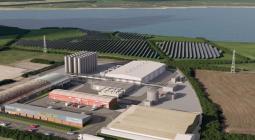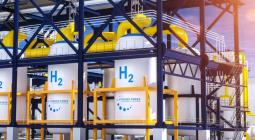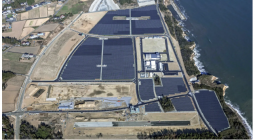Germany’s dream of building a fleet of hydrogen-fired power plants is faltering
Plans to build a fleet of hydrogen power plants to supplement wind turbines and solar panels are faltering, amid a budgetary squeeze and demands for cost-cutting from industry.
By 2035, Germany wants to produce 100% of its power in a climate-neutral way. To back up wind turbines and solar panels, whose production is expected to dominate in the coming years, the government initially envisioned a fleet of hydrogen-fired power plants.
But these plans are now faltering amid a prolonged government budgetary crisis, said Sigfried Russwurm, the president of Germany’s powerful industry association BDI.
Despite “promised decisive breakthroughs” on a power plant strategy in 2023, “none of the necessary issues have been clarified,” Russwurm said on Tuesday (16 January).
How did we get there?
In early August 2023, the German government triumphantly announced that the European Commission had essentially greenlit its plan for subsidised backup power plants.
That meant 8.8 GW of dedicated hydrogen power plants, alongside 15 GW of natural gas-powered ones that ought to switch to hydrogen by 2035 at the latest, in total representing about one-third of the German peak power demand of 2023. Climate-friendly power at the press of a button.
Because these plants would likely only produce power in periods of sustained low wind and low sun – known as “kalte Dunkelflaute” – they are unlikely to make a profit without state support.
And critically, the annual €7 billion earmarked for this purpose “evaporated” following a ruling from Germany’s top court, which restricted the government’s use of credit lines approved during the COVID-19 crisis.
With no hydrogen plants available as backup, coal power will likely be needed to fill the gap, the BDI chief warned.
“As long as the prospect of new backup power plants based on hydrogen does not get off the ground […] the solution in Germany will be the continued operation of coal-fired power plants,” Russwurm told the press on Tuesday (16 January).
Starting early was crucial to get construction started, but with “completely unclear” business models and financing, the hydrogen-fired power plants simply won’t happen, the BDI chief added.
This could be another blow for German industry after the country completed its nuclear phase-out last year and was forced to cut supplies of cheap Russian gas following Moscow’s military assault on Ukraine.
“It would be bizarre and embarrassing if Germany, a country with one of the most ambitious decarbonisation strategies, ended up depending on the continued operation of its coal-fired power plants,” Russwurm said.
Industry groups are now urging the government to take action. “The Federal Government must now get its act together: We need a power plant strategy with clear framework conditions,” said energy industry association BDEW on 11 January.
“At least 15 gigawatts (GW) of new secure generation capacity will be needed in Germany by 2030,” the association added.
Forget hydrogen, focus on gas
Given budgetary constraints, the two industry associations are urgning the government to cut corners and ditch plans for hydrogen-fired power plants.
“To significantly reduce complexity and costs,” BDEW stresses the need to “reevaluate” the role afforded to hydrogen peak and hybrid power plants, due to their expensive components and limited impacts on supply security.
Russwurm is of a similar mind. Outlining the BDI’s priorities for the year, he used metaphors to explain what a hydrogen-fired power plant would look like.
Existing power plants can’t run on “pure” hydrogen because the “burners would simply melt”, he explained. Addressing this would require retrofitting the plants with ceramics, which would make them look like the nose of a spaceship folded inwards – a process that can be done but is costly, the BDI chief said.
“If these turbines are only supposed to run when the sun isn’t shining and the wind isn’t blowing, then they will be extremely expensive,” he added.
“I’m not even talking about the cost of hydrogen, which we don’t have, but only the investment costs of these new gas turbines and their new peripherals.”
Ultimately, this means Germany’s plan to entirely phase out coal power by 2030 looks unlikely to materialise. Instead, Germany will have to continue relying on gas-fired power plants to match growing demand for electricity.
Cover photo: Germany's coal power plants, pictured, may have to cover the difference amid continued issues with financing their successors - futuristic hydrogen power plants. [EPA-EFE/SASCHA STEINBACH]





